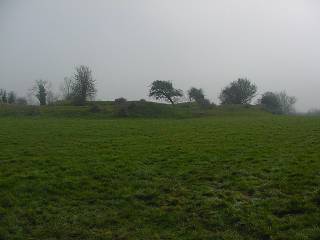
Mi Past
(This is part of the text for the film we made on the history of the Celts and of our local ring-fort, Rathbeagh)
The Celts
Introduction
For Mi Past we decided to investigate the Celts. The reason we chose the Celts was because about three kilometres from our school is a very big rath, or ring-fort, called Rathbeagh. This is a view of Rathbeagh from the road. This is believed to have been the home, and the burial place, of the first Celtic King of Ireland. The King’s name was Heremon, and we found out all about him in the old stories from ancient Ireland.
 |
|
This is the ringfort at Rathbeagh.
It is believed that Heremon, the first High King of Ireland, is buried
here.
|
We wondered why Rathbeagh is not more famous. We discovered some interesting facts:
For example:
Have you ever heard of Scotland?
I thought so! The name “Scotland” is very well known. Scotland is called after Scota. Scota was Heremon’s mother.
Have you ever heard of Tara?
I thought so! The name Tara is also very well known. Tara, or “Teamhair” in Irish, is called after Tea Tefi. Tea was Heremon’s wife. She is supposed to be buried at Tara.
Have you ever heard of the Liffey?
I thought so! The name Liffey is also very famous. The Liffey is called after Heremon’s horse Life.
And there’s more .................
Have you ever heard of Leinster?
I thought so! Leinster, “Laighean” in Irish, is called after one of Heremon’s sons.
Have you ever heard of Minster?
I thought so! Munster, “Mumhan” in Irish, is called after another of Heremon’s sons.
Have you ever heard of Ireland? I thought so!
Ireland is called after “Ir”, Heremon’s youngest brother.
Have you ever heard of Rathbeagh?
Didn’t think so!
So how come no-one knows about Rathbeagh, where King Heremon himself, lived and was buried?
In our project we began to investigate. In the ancient stories we found out that Heremon was the first Milesian king of Ireland. The stories about the Milesians are really describing the first Celts to come to Ireland. So we began our investigation by looking at the Celts.
The Origins of the Celts
Q. You did some research on the Celts. Where did the Celts come from?
A. We don’t know for certain where the Celts came from originally, but we can trace them back to the centre of Europe nearly 3000 years ago. About that time Celtic warriors began to ride on horseback and to use iron weapons. This made them very powerful in warfare. They also became very rich because they knew how to mine salt and copper. Historians divide the history of the Celts into two main eras the Hallstatt era and the La Téne.
Q. You’re the expert on Hallstatt. What is Hallstatt?
A. Hallstatt is a small town in Austria. High above the town is the mountain Salzberg which is literally “salt mountain”. People have been mining salt from it since the Bronze Age. Using bronze picks, wedges, and chisels, they bored as much as 1,200 feet into the mountainside. Hundreds of years later, miners working in the Hallstatt mines sometimes came across objects used or worn by these ancient miners. These objects were preserved by the salt.
The owner of the mines became very curious about these ancient miners. He started a search for more clues about them. And found the contents of 993 graves. All this was noted in a diary. All the items that were found are all from what is now called the Hallstatt era (750B.C-450B.C).
So now any items found in a Celtic site that belong to this period are called after Hallstatt. The name Hallstatt is also used to describe the way of life of the Celts at that time and the artwork that they produced. Hallstatt art is mostly based on nature and they seemed to be better at drawing animals than people.
Q. Did you discover what La Téne is?
A. La Téne is the name that is given to Celtic art from a later time than Hallstatt. The La Téne period is from about 450B.C to 50B.C. La Téne is a small island in Lake Neuchatel in Switzerland. In the 1850’s the water in the lake was much lower than usual, and more of the island could be seen. Some ancient timber could be seen above the water for the first time.
A local archaeologist began to investigate. Over the next few years he found the remains of a bridge and over 50 long iron swords with beautiful designs on them. It appeared that the Celts had thrown the swords over the bridge as offerings to the gods. The art on the swords was a new type of art with lots of curls and spirals. This new type of art was called La Téne.
 |
|
A Celtic Torc
|
Q. The Celts brought their art with them when they moved out of Central Europe. When did they start to move?
A. About 500B.C the Celts began to look for new farm land. Some of them followed the great river valleys such as the Rhine and the Danube. They moved east and south to places as far away as Turkey, Greece, and Italy. Others moved north and west to Germany, France, and Spain. Some of them crossed the sea to England and Ireland. For the next 200 years the Celts fought wars against the Roman Empire.
The Roman army was the strongest fighting force in Europe and by the year 60 A.D the power of the Celts was almost completely destroyed. The only parts of Europe where the Celts still had power were Brittany, Scotland, Wales and, of course, Ireland.
Religion
Q. What do we know about the religion of the Celts?
A. Celtic religion had close connections with nature and the environment. This was because most Celts were farmers who relied on nature to make their crops grow and ripen. Without good crops farmers and their families would go hungry.
The Celts had many gods such as Lugh, Bridget and An Dagda. Others belonged to one particular tribe or to one place, such as a pool, a spring, a tree or a stone. The Celts made sacrifices to the gods to keep them happy.
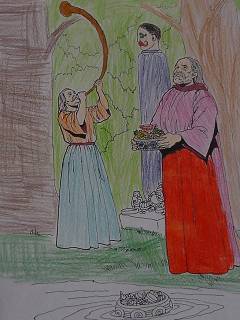 |
|
Celtic Druids offering sacrifice.
The Celts often threw things into water as an offering to the Gods.
|
Q. What were the Celtic religious leaders called?
A. The Celtic religious leaders were called druids. They were wise men of the tribe and were often political leaders too. It took as long as twenty years to become a druid. They were responsible for organising the various ceremonies throughout the year. Some druids helped to heal the sick partly by demanding sacrifices and by using herbs and medicines. Druids also decided which days were lucky and which were not.
Q. What did the Celts believe in?
A. They believed in many gods. One such god was Lugh. Lugh was known as Lugh of the Long Arm. He could jump on a bubble without bursting it. He was also known as Lugh of the Shining Face because the sun shone from Lugh’s face.
Once an evil king was wondering why the sun rose in the west instead of the east. His druids told him that the light he saw was the face of Lugh. Lugh wore the Milky Way as his silver chain. He carried the rainbow as his sling. His sword was called Answerer it could cut through anything. His boat was called Wave Sweeper it could find it’s way across the sea by reading the minds of the sailors. His horse could carry him over land or sea. Lugh’s name means ‘shining one’. He was also known as Ildánach, which means Master of Arts and crafts.
Lugh travelled to Tara then to the palace of king Nuada. The keeper of the
gate greeted him. And asked him what talents he had. Then Lugh replied
“I am a Wright”.
The keeper said
“We already have a Wright”.
Then Lugh said
“I am a Smith, a Champion, a Harper, a Hero, a Poet, a Historian and Craftsman”.
The keeper said
“We have all those” but, then Lugh replied
“Have you one person who can do all those?”
The keeper replied
“NO you can enter now”.
Lughnasa is the festival of Lugh.
Another god was Bridget. Bridget was goddess of poetry and wisdom. Her name means “Queen” or “the powerful one”. A large Celtic tribe known as the Brigantes took their name from her. She is the daughter of another Celtic god called An Dagda. Her festival is Imbolc.
An Dagda was known as the good god. An Dagda is considered to be the father of the gods and goddess. Samhain is the festival of An Dagda.
Q. Did the Celts have seasons and festivals?
A. The Celtic year was divided into four parts one for each season. There was a festival at the change of one season to another. Samain, Imbolc, Bealtaine and Lughnasa are the festivals.
Samain Was celebrated on November 1st, Imbolc was celebrated on February 1st, Bealtaine was celebrated on May 1st, and Lughnasa was celebrated on August 1st. The festivals were mainly religious but there was still games and fun.
Samain was the most important because it was the end of one year and the beginning of another. Samain was also a time of the living and the dead. The herds and flocks of animals would be gathered before the winter. Some would be kept for breeding. Other animals would be killed. The night before Samain, which we now celebrate as Halloween, was thought of as a magical time. The people would make sacrifices to the gods, hoping that the next year would bring good fortune. They were also very careful so that they wouldn’t make the gods angry, because this would bring misfortune.
Imbolc was dedicated to the goddess Brigit and seemed to have a connection with the minding of sheep and the sowing of crops. This was the time when sheep had lambs and feed them with their milk.
Bealtaine was also very important. This was one of the first sings of summer. It was the beginning of the warm season and the cattle would be out for grazing. All around the country two great fires would be lit and the cattle would be driven in between the two Fires to protect them against disease.
At Lughnasa sacrifices would be made to the god Lug to make sure they would get good ripening of crops and to gain good harvest.
Q. What kind of burial customs did the Celts have?
A. The Celts buried their dead with their favourite jewels, weapons, clothing and even joints of meat, cauldrons, plates, wine and cups. Wealthy Celts were buried with these as well as their horses and chariots but the Celts made sure that the horses were old and the chariots were worn-out before they were buried.
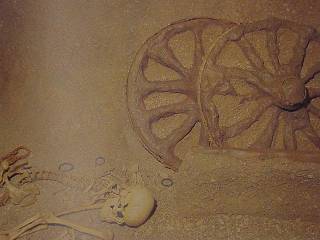 |
|
A Celtic Burial with chariot
wheels. Celts sometimes buried their chariots with the body.
|
How they lived
In Ireland and Britain most Celtic houses were round
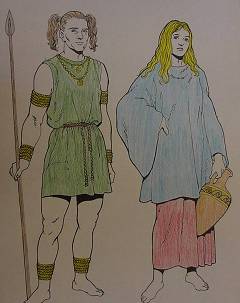 |
|
A Celtic man and woman
|
Q. What were the main foods the Celts ate?
A. The main foods were: milk, cheese and meat. Bread was not eaten often, but corn was used to make lots of different porridges. Rather than kept for their meat cattle were kept for their milk.
Q. What cattle would be killed for their meat?
A. The cattle killed were normally old, unwanted bull calves, or maimed ones. Because they were old, the meat would have been tough and hard to boil.
Q. Did the Celts wash often?
A. Yes. They washed very often. They used large wooden bathtubs, and the water was heated by throwing hot stones into the bathtubs. The stones were heated around a fire.
Q. What kind of work did women do?
A. Women spent most of the time in their houses feeding and clothing their families. They made fresh bread everyday and spent lots of time making new clothes for their families.
Q. Did children ever help with the housework?
A. Yes. Boys usually didn’t help very often, but girls almost always helped with the housework.
The Celts Come to Ireland
Q. What do the ancient stories tell us about the Celts coming to Ireland?
A. The ancient stories tell us about how Ireland was invaded by several different tribes in ancient times. The last of these were the Milesians and the stories about the Milesians were really describing the first Celts to come to Ireland.
Q. Where did the Milesians come from?
A. Milesius was the King of Spain. He had been in Egypt defending it against the Kings of Ethiopia. When he returned to Spain he sent an army to explore a fertile land to the north. There was a prophecy that they would find an island called Inis Fáil – the Island of Destiny.
When his army returned Milesius discovered that his son had been killed by the kings of the Tuatha de Danaan in Ireland. Milesius gathered another army to take revenge on the people of Ireland. But he died before they could set off.
The army set out in a large fleet of ships. They met many difficulties caused by the magic used by the Tuatha de Danaan.
Q. Did the Milesians manage to defeat the Tuatha de Danaan?
A. The Tuatha de Danaan made Ireland look like a pig. Then they caused a great storm and scattered the ships of the Milesians. Many of the ships sank and five of the eight sons of Milesius were drowned. However the ships commanded by Heremon, Heber and Amergin landed safely and they defeated the Tuatha de Danaan at Sliabh Mis, in Kerry. There was a second battle at Tailtin, in Meath. The Tuatha de Danaan kings were killed. They could never again defeat the Milesians. They fled to lonely hills, caves and hill-forts where they still live today!
The Stone of Destiny
Q. Where is the stone of destiny?
A. In the coronation chair in Westminster Abbey in London, there is a stone called the stone of destiny. The kings of England and before that, the kings of Scotland and before that, the kings of Ireland were crowned on the stone.
Q. When is the first time we hear of the stone in history?
A. The stone’s history begins in the bible, in the Book of Genesis. Jacob camped overnight in a field. He put his cloak on a stone and used it as a pillow. While he was sleeping he dreamt he saw a ladder reaching into heaven, with angels going up and down it. At the top of the ladder was God. When Jacob had woken up he said: “This is the house of God” and named the place Beth-el, meaning house of God.
He picked up the stone he used as a pillow and set it upright and dedicated the stone with an offering of oil. The stone was brought to Egypt by Jacob’s sons.
Q. How was the stone brought to Ireland?
A. An Egyptian princess called Princess Tea Tephi is said to have been married to Heremon, the son of Milesius, the king of the Milesians. It is also said that when the Milesians came to Ireland, Princess Tea Tephi who came with them, is claimed to have brought a lot of priceless relics showing Hebrew identity and one of them was the stone of destiny. For many years, the kings of Ireland were crowned upon it.
Q. Who brought the stone to Scotland?
A. It was brought to Scotland by Fergus for his coronation. Fergus was the king of the Scots. For 450 years, the kings of Scotland were crowned upon the stone.
Q. Who brought it to England?
A. King Edward 1st brought it to England, where it was put into the coronation chair. To this day, the Kings and Queens of England have been crowned upon it.
War and Weapons
Q. What battle habits did the Celts have?
A. The Celts had a bad habit of running into battle naked, except for a torc (a ring around the neck) and a helmet. There were two reasons for this. One was to scare the enemy, the other was because if they got stabbed, they thought the clothes would infect them. Another habit was cutting off the heads they collected on the sides of their chariots. They would also leave them as offerings to Gods, or leave them at their homes. Heads were like trophies to the Celts.
Q. How did the Celts prepare themselves before battle?
A. Before the battle the Celts washed their hair in limes water. This made it stand up in stiff spikes when it dried. They also painted or dyed their hair. This made them look more fierce. A lot of the time they got drunk before battle.
Q. When did the Celts first few wars against the Romans start?
A. Their first few wars against the Romans started soon after 400 B.C. when migrating Celts from France arrived in the north of Italy. In 387 B.C. Celts attacked Rome. The Romans were determined to defeat the Celts and take over their lands. It took a lot of years but they succeeded.
Q. Did the Romans think the Celts were good fighters?
A. The Romans were impressed by the Celts fast two horse chariots which they would ride into battle. But they soon discovered that most of the Celts who fought as individuals were no match for their organised disciplined way of fighting. If they were captured by the Romans, Celtic men, women and children were either killed or sold as slaves.
Q. In Europe what countries did the Romans not take over?
A. The Romans captured most of Europe and Britain. The only countries in Europe that the Romans didn’t capture were Ireland, Scotland, the Isle of Man and Brittany. In A.D. 122 the Roman Emperor Hadrian, ordered a massive wall to be built in the north of England to mark the border between the land ruled by Rome and land in Scotland where Celtic chiefs still had power.
Rathbeagh
(This is part of the script for the film we made on the site at Rathbeagh)
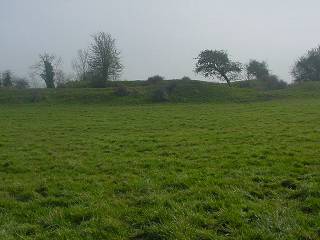 |
|
A view of the rath at Rathbeagh
|
Introduction
This is Rathbeagh, the home and the burial place of Heremon. When we went to investigate the site we were looking for evidence that this was not just any ordinary rath. Most raths were almost a perfect circle. To find out if this one is we measured the longest diameter and the shortest diameter. We divided the shortest by the longest. The nearer our answer was to 1.0 the nearer the rath was to a perfect circle. Most raths have a figure between 0.9 and 1.0.
Less Raths in Kilkenny
There are less raths around Kilkenny than many other counties. Historians think this is because the Normans cleared most of them when they began farming in the area. Rathbeagh is now the only rath left along the banks of the Nore between Ballyragget and Kilkenny.
Why was Rathbeagh left alone?
Maybe it was because it was important even in Norman times.
Testing if Rathbeagh is a Circle
When we tested if the rath is a circle the figure we got was 0.68. This was a long way off a perfect circle. This might be because the rath might have been built on top of an older fort. This might mean that Rathbeagh is older than most other raths.
Bones we Found
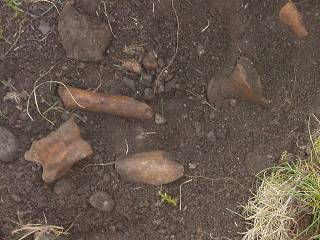 |
|
We found some bones where cattle
had disturbed. The bones looked like human bones but we couldn't be sure.
We left them where we found them. Could they be the bones of Heremon?
|
These are some of the bits of bones we found. Could they be the bones of Heremon? This is a part of the rath that has been disturbed by cattle. These are some bones that we found in the soil. We do not know if they are animal bones or human bones. We are not going to take them. We will leave them where we found them Maybe they might be Heremon’s bones!
Something else that we found on the rath! What’s this? We don’t know. But we don’t think it’s around since the time of Heremon!
The Entrance to the Rath
The entrance to most ring-forts was usually facing south-east. The entrance to Rathbeagh is facing south-west. This is unusual. Sometimes the entrance was built facing another ring-fort nearby. There is no hillfort to the south-west of Rathbeagh and there is no sign of one on any old maps.
Rath of a King?
The Ancient Irish Laws had certain measurements for the fort of a King. We tried to find out if Rathbeagh was big enough to be the fort of a King. A local man Pat Tallis showed us how to measure levels using a Dumpy Level. We measured the size of the rath, the size of the ditch around it and the bank around the outside, and the height of the rath above the river.
 |
|
This is Pat Tallis showing
us how to use the Dumpy Level to take levels.
|
The laws said that a King’s rath should have a stockade of 42.5 metres. The diameter of Rathbeagh was 39 metres which was just about right. The laws also said that the thickness of the bank should be 2.1 metres. The bank at Rathbeagh is 11 metres. The height of the bank was to be 3.6 metres. At Rathbeagh the height of the bank is from 3.5 metres in some places to 4.2 metres in other places.
We discovered that Rathbeagh is big enough to have been the rath of a King. This doesn’t prove that a King lived here or was buried here. But the evidence we found matches the description of a Celtic King’s rath from the ancient laws.
We are confident that Rathbeagh was once home to a powerful Celtic King.
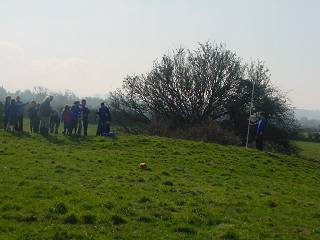 |
|
This is us taking levels on
the rath.
|
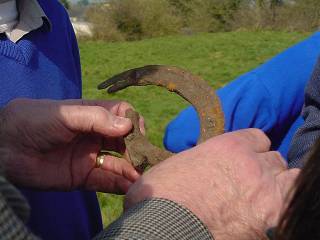 |
|
Here is something else we found
on the rath. We don't know what it is but it doesn't seem to be very old.
|
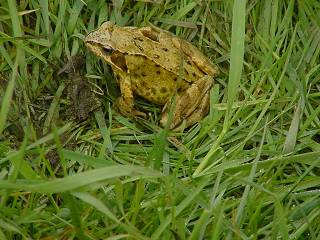 |
|
And here is something else
we found.
|